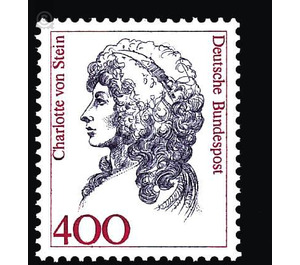Permanent series: Women of German History - Germany / Federal Republic of Germany 1992 - 400 Pfennig
Theme: Health & Human
| Country | Germany / Federal Republic of Germany |
| Issue Date | 1992 |
| Face Value | 400.00 |
| Color | grey white |
| Perforation | K 14 |
| Printing Type | 2-color Typography |
| Stamp Type | Postage stamp |
| Item Type | Stamp |
| Chronological Issue Number | 1455 |
| Chronological Chapter | GER-BRD |
| SID | 720216 |
| In 37 Wishlists | |
Charlotte von Stein's life, which is rather poor in external events, is soon told; an appreciation of her personality is even more difficult: what she has made "immortal" is less to her than her fateful contact with Goethe. Charlotte Albertine Ernestine von Stein was born on December 25, 1742 in Eisenach, as the daughter of the traveling march of Schardt (since 1743 Weimar court marshal); the mother comes from Scottish nobility. Grown up in cramped conditions and rigorously trained in Calvinism, contemporaries portray Charlotte as a talented woman in artistic matters of graceful, winning appearance. Already at the age of fifteen she enters the personal service of Duchess Anna Amalia of Saxe-Weimar as a lady-in-waiting. She gives it up when, at twenty-two, in 1764 she married the ducal stable master (later chief equerry) Friedrich Josias Freiherr von Stein (1735-1793), probably a well-to-do man, a wealthy, respected, handsome and kindhearted man. Fully committed to the farm, he is absorbed in horses, hunts, and journeys, and he does not give much understanding to his wife's aesthetic interests. Although there is hardly any talk of a deeper inclination, the relationship of the spouses, probably not only to the outside world, remains unclouded throughout life. While she gives birth to no less than seven children until 1774 (of whom only two sons reach adulthood), she usually stays in the small, contemplative residence, especially in the circle of the duchesses and court ladies or withdrawn on the Steinschen Gut Gross-Kochberg near Rudolstadt. This is how Charlotte von Stein comes in, let's say, a less conspicuous life. Of course, this changes almost overnight when Goethe arrives in Weimar in late autumn 1775, to which the young Duke Carl August invited him. Shortly thereafter, the seven-year younger takes a deep passion to that woman who is said to have sound mind, feeling and truth. Despite initial reluctance Charlotte von Stein can not escape his courtship. Goethe, now a regular guest at Stein's house, is cordially welcomed into the family and involved in their everyday life. Daily, often several times a day, letters and tickets go back and forth. Goethe often uses the word "love" or plays around it. Charlotte gently, but surely rejects it as often. Under the influence of the mature woman Goethe learns to curb his stormy passions, indeed to renounce them. The ideal of freedom of the forerunner and the aggressor turns into voluntary recognition of moral orders. The friend, like his sister before, became the closest adviser and first reader of all that Goethe wrote between 1776 and 1786. In some of his female figures, such as Iphigenie, the Princess of Tasso, and even in Natalie from Elective Affinities, one may well recognize features of her. In Italy, where he secretly sets out in 1786 - even Charlotte is not initiated and remains upset - Goethe has become a different person. Carefree joie de vivre has broken its tracks there. Just returned, he takes in the summer of 1788 Christiane Vulpius in the house. The break with Charlotte, whom Goethe seeks to avoid, especially since he does not mean to take away from her, is only a matter of time: he takes place in June 1789. With vicious taunts, especially against the "Mamsell," she takes her revenge and writes In the meanwhile, widowed, in a five-bar tragedy with the typical title "Dido" (1794), studded with sooty iron, her bitterness from the heart. It was not until 1801, when Goethe fell ill with death, that a restrained rapprochement began, which gradually solidified into a modus vivendi. On January 6, 1827, Charlotte von Stein dies impoverished and lonely. (Text: Ernst Dietrich Eckhardt, Free German High Foundation Frankfurt Goethe Museum)


